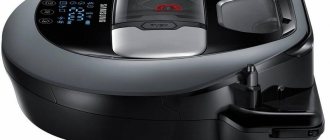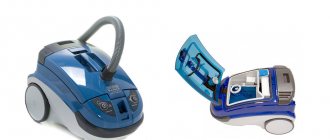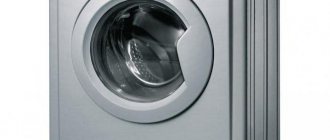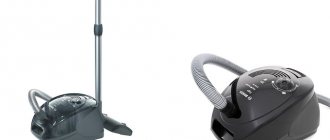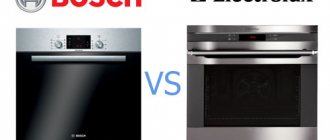A vacuum cleaner serves as a reliable and faithful assistant for every housewife for many years. To extend its service life, it is important to properly monitor the operation of the device, promptly replace broken parts and clean filters. You will learn how to properly clean the filter from contamination in our article.
When choosing a vacuum cleaner model with a cyclone filter, it is important for you to pay attention to the strength of the waste collection container. It should be strong enough not to burst.
Large particles of debris often knock against the walls of the container, creating additional noise.
The advantages of this choice include the fact that you do not have to regularly change dust collectors. Such a vacuum cleaner should not be heavy, which means it will be easy for you to work with it.
Minus - while cleaning the container you will be forced to come into contact with dust
Can it be washed?
It doesn’t matter what model of vacuum cleaner you have and what type of filter it has, it needs timely replacement and, sometimes, proper cleaning.
In general, we strongly advise against exposing any filter elements to water. This may cause your vacuum cleaner to break down. We recommend wiping with a damp cloth or napkin and tapping the filter structure thoroughly.
Important! Before putting the wet filter back into the vacuum cleaner body, dry it in a dry, warm place, but not on the battery - the filter will become deformed!
a disposable dust bag as a filter , then you do not need to clean it. It is enough to replace it with a new one in a timely manner.
The reusable fabric dust bag requires regular and thorough cleaning. First, carefully pour the contents of the bag into the bag. Try to do this outside or in the bathroom so that dust does not have a chance to settle on clean textiles. Then the bag needs to be washed and dried thoroughly, but here it is worth drawing a direct analogy with clothing - the more often you wash the dust collector, the faster it will wear out and fail.
Replacing a disposable dust bag with a new one or cleaning a reusable dust bag from dirt is much easier than cleaning an aqua filter .
The cyclone filter should be handled carefully due to two aspects: it can be fragile and become damaged during cleaning, or if it is not cleaned carefully, all the dust can end up in the air or on the floor.
The aquafilter should also be removed from the vacuum cleaner with extreme caution. If you can't lift heavy objects, then a vacuum cleaner with an aqua filter is not for you.
You empty a container of dirty water by pouring the contents down the drain, and then clean it without using cleaning agents or detergents. Then wipe it dry with a napkin and put it back in place. Read more about models and types of vacuum cleaner bags here.
How to clean the Hepa filter of a vacuum cleaner
Fine filters - can be paper (disposable) or polymer (reusable), and also have different shapes - their distinctive feature is a ribbed surface.
A paper Hepa filter can only be cleaned using the dry method; if such a filter is washed after drying, the suction draft decreases.
So, for cleaning you need:
- remove the filter from the vacuum cleaner,
- tap the filter seal on the edge of the garbage can to shake out dust particles,
- the remaining dirt can be cleaned with a thick brush or blown out using a compressor to inflate the mattress.
A disposable Hepa filter is replaced with a new one when dusty debris cannot be blown out, when the paper accordion is deformed, or according to the replacement period suggested by the manufacturer.
A polymer Hepa filter, unlike a paper one, can be washed to remove clogged dust, and it can be cleaned well even using a dry method:
- shake out the accumulated dust into the trash bin by tapping with the tight edge of the filter (you can additionally blow the filter with a compressor or a second vacuum cleaner); if the cleanliness of the filter element is satisfactory, insert it back into the device,
- If the polymer material does not look clean enough, wash it:
- pour water into a bucket (so that it covers the filter),
- immerse the filter element for 10 minutes,
- swirl it around a little (do not wash the filter with hard brushes and sponges),
- then rinse under running water,
- leave on a paper or cotton towel to dry for approximately 12-24 hours (until completely dry - a damp filter should not be placed in a vacuum cleaner, it will damage the motor and become moldy in an unventilated environment),
- return the dry filter to its place in the vacuum cleaner.
Which is better?
The easiest way is with a disposable dust bag. It's easy to replace, you don't have to breathe dust while cleaning it, but you'll have to regularly spend money on new consumables.
Vacuum cleaners with an aqua filter can boast of being hygienic, but such units are quite heavy , since their body contains a container filled with water. Therefore, in general, it is worth classifying this type of vacuum cleaner as a specialized anti-allergenic device.
Cyclone vacuum cleaners break down more often than others. Their weakest point is in the garbage collection bowl. She just bursts. Therefore, it is so important to pay attention to what material all the parts of such a vacuum cleaner are made of.
How to wash the foam rubber pre-motor filter of a vacuum cleaner
The foam/mesh filter is used for pre-engine air purification.
The foam layer can additionally have a mesh layer of fabric; the pre-motor filter is usually paired with an additional coarse-mesh filter (also foam) - for rough air purification, it protects the motor from large debris.
How to clean the foam filter of a vacuum cleaner :
- To remove dust, remove the foam insert from the plastic case and rinse it in lukewarm water; you can pre-soak the filter for 5-10 minutes. You can use detergents, but they must be washed very well so as not to damage the vacuum cleaner.
- After cleaning the foam, leave it to dry in a ventilated place and place it back in the vacuum cleaner after 24-48 hours (after drying).
The large-mesh foam filter can also be washed well with water and inserted into the vacuum cleaner connector only after drying.
We clean the brush and hose of the vacuum cleaner
Have all filters been cleaned, but power has not returned? Most likely the hose is clogged. The situation occurs when large particles of debris get inside and remain there, not reaching the filter. To clean the hose, disconnect it from the vacuum cleaner and nozzle. Now clean it using any available means, you can use wire or a plumbing cable.
Nozzles and brushes require cleaning even more often than the hose. If we are not talking about turbo nozzles rotating from the engine, then this is not so scary. The cleaning efficiency will simply decrease. A clogged turbo nozzle causes rotation to stop and the engine to restart, which is very harmful. The problem occurs as a result of the collection of hair and threads remaining on the bristles. If necessary, disassemble the structure by unscrewing the bolts and clean the bristles. It's easy enough to remove debris from regular nozzles.
How to clean a cyclone filter
The filter container is cleaned of compressed dust after each cleaning of the apartment with a vacuum cleaner.
- We open the compartment with dirt above the garbage bag and dump out the dusty compact.
- Next, check if there are any additional lids in the container; often in the center there is a compartment that creates an air funnel in which hair and pet hair can get wrapped up.
After removing the main dust from the cyclone filter storage container, wipe it with a slightly damp cloth to remove the layer of dust settled on the walls.
Cleaning the aqua filter
The water filter in a vacuum cleaner is a bucket filled with water and detergent.
After cleaning the apartment, the liquid must be drained into the toilet, otherwise the equipment will deteriorate and fungus will appear in the compartment.
Cleaning this filter involves cleaning the walls of the container from dirt residues that remain in abundance after draining the liquid. After rinsing the bucket, it is advisable to dry it and only then insert it into the vacuum cleaner connector.
Vacuum cleaner prevention
The correct functioning of the device depends 80% on proper operation. To avoid breakdowns and costly repairs in the future, follow simple rules for using vacuum cleaners:
- Regularly check and replace failed filters - they help the device’s engine stay clean;
- To clean sharp glass and metal objects, large parts and pieces of fabric, use another method, such as a mop or broom;
- If during operation there is a burning smell, smoke, or increased vibration, the device should be immediately de-energized and the external filters should be inspected and cleaned.
- If there are serious problems, it is better to entrust repairs to a specialist.
Meaning of error 3e on a Samsung washing machine
Carbon filter
It is quite rare, its main purpose is to absorb unpleasant odors. Suitable for pet owners. It is a rectangular cassette filled with activated filter granules. The service life is 2–3 months, and it does not matter how actively the vacuum cleaner itself is used. Because the cassette absorbs odors even when the vacuum cleaner is not working. This filter is completely disposable, its low prevalence is also explained by its high price - from 30 dollars.
The standard filtration procedure in vacuum cleaners takes place in three stages.
- The collected dust is accumulated in a special compartment - an aqua filter or a dust bag.
- Cleaning in a permanent or replaceable engine filter. It performs the function of protecting the device’s motor from clogging.
- Fine cleaning, for example, using a HEPA filter.
What filters exist for vacuum cleaners - types and features
The following types of filters exist:
- Bag. Made from synthetic or paper. There are both reusable and disposable options. The main task is to keep the dust inside.
- Aqua filters. Placed above the water. Dust, penetrating into the cylinder, is wetted with water and settles at the bottom.
- Rough cleaning. It occurs in the compartment under large garbage. It gets clogged quickly and requires regular replacement.
- Fine cleaning. There are microfilters, electrostatic and HEPA filters. They effectively remove even small particles, are highly efficient, and do not allow dust to be thrown back out of the vacuum cleaner. High-quality air filters for vacuum cleaners remove not only dust from the air, but also allergens - pollen, micro mites, plant spores.
- Cyclonic - equipped with a container for dust and dirt, which must be emptied after each tidy.
Types of Hera filters - in which devices they are used
All HEPA filters are classified into two main types: disposable and reusable.
Disposable devices are made of fiberglass and paper. They are used in the production of budget vacuum cleaners, since their cost is also low, and the particle throughput is only up to 0.3 microns.
Reusable ones are made of fluoroplastic, they are more durable compared to paper ones, and they can be washed. These filters are called ePTFE. Prevents the passage of contaminants up to 0.06 microns in size.
How the device works
These filters are designed to retain particles up to 1 micron in size. The fan drives the air flow, due to which foreign particles settle on the filter, including allergens: plant pollen, animal hair, fungal spores, dust mites. The cleaning efficiency can reach 99%. This figure is influenced by the thickness of the filter itself, as well as the diameter of the fiber.
The greatest effect of use is observed in enclosed spaces, where air is passed through the filter several times. When heavily soiled, the device becomes ineffective, but on average replacement is needed every one to three years.
VIDEO REVIEW
Filtration is provided through effects such as:
- Grip effect. Particles of any size cling to the filter microfibers, and subsequent particles cling to the previous ones.
- The effect of inertia. Most noticeable on large particles. Due to their large diameter, they cannot bend around the fibers, so they move straight until they collide with an obstacle.
- Diffusion effect. Small contaminants up to 0.1 microns in size can move in the opposite direction of the air flow in a curvilinear manner, thereby increasing the likelihood of the particle stopping either due to the effect of entanglement or inertia.
Case disassembly
The upper part of the body is secured with self-tapping screws. Unscrew them with a screwdriver and screwdriver to remove the cover. If you are removing the dust container, also unscrew the screws underneath it.
Tip: Place loose screws in a small, stable container to prevent them from getting lost.
The main part of the case is held on by self-tapping screws or special latches. After removal, access to the motherboard opens. If you are sure that the board is operating normally, move it aside to avoid damage during diagnostics and repairs. To do this, disconnect its connectors and unscrew the screw in the central part.
Next to the engine there is a check valve - a small button that can be pulled out quite simply. The valve is needed to stop the engine if it becomes clogged due to strong suction force. Without a valve, the electric motor may burn out.
To access the engine itself, remove the bolted casing and rubber surrounds. There may also be protective pads made of foam rubber or felt next to the motor. They secure the position of the engine and do not allow it to touch the walls of the casing.
Engine repair and replacement
Signs that you need to check the vacuum cleaner motor:
- the device hums or hisses when connected to the network,
- the vacuum cleaner sucks up dust poorly, does not suck it in or even “spits it out”,
- There is a burning smell coming from the device.
First, let's inspect the engine visually: burnt elements or broken wires can be immediately visible. Wires break more often if they are made of aluminum, which is easily damaged by vibrations. Usually the integrity of the wires is compromised at the places where they are attached.
Then we’ll check the performance of the motor: pull it out, clamp it in a vice, install insulated terminals and apply voltage to them. If there are sparks, most likely there is a lot of dust and small debris inside the electric motor. Dust also accumulates in the impeller, from where it must be cleaned.
Tip: the collector body can be cleaned with an eraser, after first giving it the desired elongated, pointed shape. The eraser is inserted into the hole, the motor is turned by hand, and the dirt remains on the eraser. Clean the eraser with a cotton swab dipped in an alcohol solution.
If there is a lot of debris inside the case, open it by pressing it out using pliers, slightly bending the edges at the clamping points. Remove, clean and reinstall.
Work may be interfered with by:
- impeller imbalance;
- bearing failure;
- wear of the brushes on the sides of the commutator;
- displacement of the sealing ring at the entrance to the fan hole - it needs to be cleaned and put in place;
- crushed or damaged wires - they should be ringed;
- The thermal fuse on the motor housing has blown.
After diagnostics and repairs, blow out any remaining dust inside the engine. It's unlikely to work the first time. Repeat until no more dust clouds are blown out.
A separate article is devoted to engine repair:
How to repair a vacuum cleaner motor at home: step-by-step instructions + video
When installing a new motor on a Samsung vacuum cleaner, disconnect the terminals from the damaged part and connect to the new one. The new electric motor may differ slightly in modification. The main requirement is complete similarity of the holes and brushes, since the motor is inserted into the housing in only one way. It must fit perfectly, with all the grooves and depressions completely matching; it will not be possible to turn the motor around. Then tighten the rubber band or other sealing elements, screw in the removed screws and put the casing back on.
The video below shows the process of disassembling the vacuum cleaner and replacing the motor:
Features of disassembling the vacuum cleaner
Let us immediately warn you that if you have not previously tried to disassemble such devices, perhaps you should trust the experts. External filters are easy to remove and clean, but not everyone can disassemble the housing itself and, moreover, assemble it separately on their own; in addition, you may need special tools, such as flat-head and Phillips screwdrivers, pliers and sandpaper, if you decide to make disassemble yourself, record every step on camera. Photos or videos of the process will help you later assemble the device correctly, and you won’t end up with unnecessary parts.
Warranty for vacuum cleaners from Samsung


